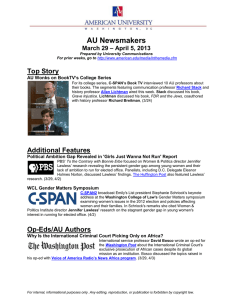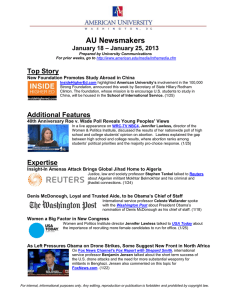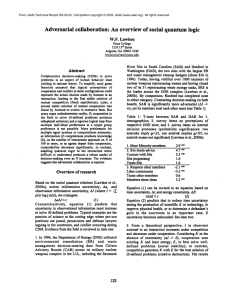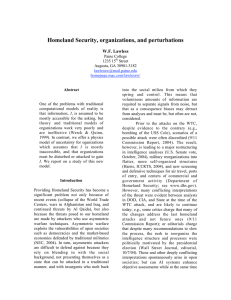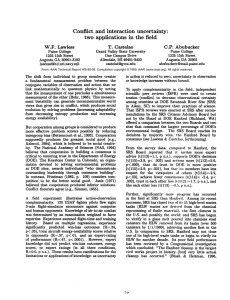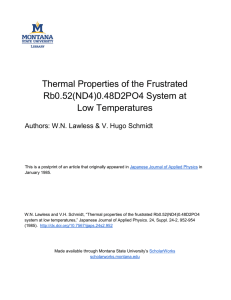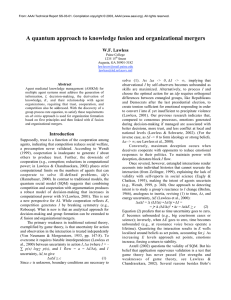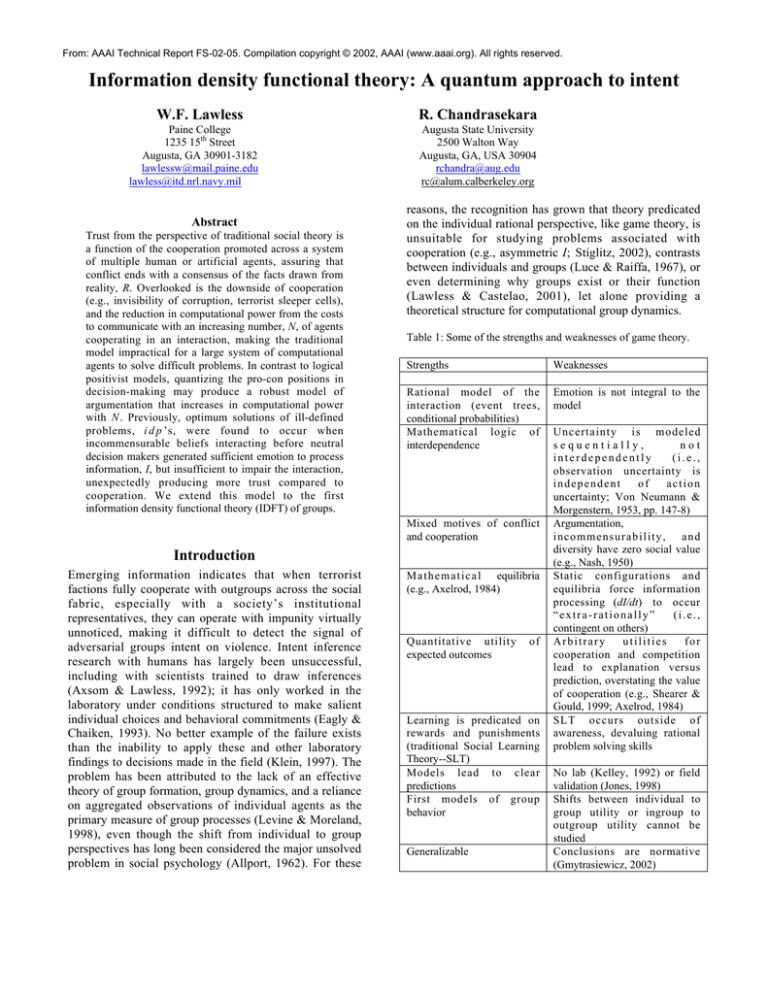
From: AAAI Technical Report FS-02-05. Compilation copyright © 2002, AAAI (www.aaai.org). All rights reserved.
Information density functional theory: A quantum approach to intent
W.F. Lawless
Paine College
1235 15th Street
Augusta, GA 30901-3182
lawlessw@mail.paine.edu
lawless@itd.nrl.navy.mil
Abstract
Trust from the perspective of traditional social theory is
a function of the cooperation promoted across a system
of multiple human or artificial agents, assuring that
conflict ends with a consensus of the facts drawn from
reality, R. Overlooked is the downside of cooperation
(e.g., invisibility of corruption, terrorist sleeper cells),
and the reduction in computational power from the costs
to communicate with an increasing number, N, of agents
cooperating in an interaction, making the traditional
model impractical for a large system of computational
agents to solve difficult problems. In contrast to logical
positivist models, quantizing the pro-con positions in
decision-making may produce a robust model of
argumentation that increases in computational power
with N. Previously, optimum solutions of ill-defined
problems, i d p ’s, were found to occur when
incommensurable beliefs interacting before neutral
decision makers generated sufficient emotion to process
information, I, but insufficient to impair the interaction,
unexpectedly producing more trust compared to
cooperation. We extend this model to the first
information density functional theory (IDFT) of groups.
R. Chandrasekara
Augusta State University
2500 Walton Way
Augusta, GA, USA 30904
rchandra@aug.edu
rc@alum.calberkeley.org
reasons, the recognition has grown that theory predicated
on the individual rational perspective, like game theory, is
unsuitable for studying problems associated with
cooperation (e.g., asymmetric I; Stiglitz, 2002), contrasts
between individuals and groups (Luce & Raiffa, 1967), or
even determining why groups exist or their function
(Lawless & Castelao, 2001), let alone providing a
theoretical structure for computational group dynamics.
Table 1: Some of the strengths and weaknesses of game theory.
Strengths
Weaknesses
Rational model of the
interaction (event trees,
conditional probabilities)
Mathematical logic of
interdependence
Emotion is not integral to the
model
Mixed motives of conflict
and cooperation
Introduction
Emerging information indicates that when terrorist
factions fully cooperate with outgroups across the social
fabric, especially with a society’s institutional
representatives, they can operate with impunity virtually
unnoticed, making it difficult to detect the signal of
adversarial groups intent on violence. Intent inference
research with humans has largely been unsuccessful,
including with scientists trained to draw inferences
(Axsom & Lawless, 1992); it has only worked in the
laboratory under conditions structured to make salient
individual choices and behavioral commitments (Eagly &
Chaiken, 1993). No better example of the failure exists
than the inability to apply these and other laboratory
findings to decisions made in the field (Klein, 1997). The
problem has been attributed to the lack of an effective
theory of group formation, group dynamics, and a reliance
on aggregated observations of individual agents as the
primary measure of group processes (Levine & Moreland,
1998), even though the shift from individual to group
perspectives has long been considered the major unsolved
problem in social psychology (Allport, 1962). For these
M a t h e m a t i c a l equilibria
(e.g., Axelrod, 1984)
Quantitative utility
expected outcomes
of
Learning is predicated on
rewards and punishments
(traditional Social Learning
Theory--SLT)
Models lead to clear
predictions
First models of group
behavior
Generalizable
Uncertainty is modeled
sequentially,
not
interdependently
(i.e.,
observation uncertainty is
independent
of
action
uncertainty; Von Neumann &
Morgenstern, 1953, pp. 147-8)
Argumentation,
incommensurability, and
diversity have zero social value
(e.g., Nash, 1950)
Static configurations and
equilibria force information
processing (dI/dt) to occur
“extra-rationally”
(i.e.,
contingent on others)
Arbitrary
utilities
for
cooperation and competition
lead to explanation versus
prediction, overstating the value
of cooperation (e.g., Shearer &
Gould, 1999; Axelrod, 1984)
SLT occurs outside of
awareness, devaluing rational
problem solving skills
No lab (Kelley, 1992) or field
validation (Jones, 1998)
Shifts between individual to
group utility or ingroup to
outgroup utility cannot be
studied
Conclusions are normative
(Gmytrasiewicz, 2002)
Rational theorists counter that models of the
interaction from game theory have provided a successful
test bed for military maneuvers, including nuclear war
and terrorism (e.g., Woo, 2002). One of the benefits of
game theory is that it allows an event tree to be
constructed with conditional probabilities that follow the
planning steps in a military engagement, or the
interdependent steps and contingencies that a terrorist
might follow to attack a target. However, the probabilities
for each of these steps are often estimated by experts,
rendering a value little different from expert planning. For
strengths and weaknesses of rational theory, specifically
game theory, see Table 1. Regarding agent based models
(ABM’s), while traditional social learning theory, such as
reward reinforcement, affords the means for machine
learning (Bankes, 2002), this learning is “extra-rational”
or outside of agent awareness, devaluing mindful problem
solving (Lawless, 2002).
In past research, we have shown that the benefits
associated with competitive, market economies and
liberal democracies include modern science, sophisticated
technology, better health, and less corruption (Lawless &
Castelao, 2001). These benefits are so pervasive
compared to those from other forms of decision-making
(e.g., democracies do not suffer from famine, and are less
likely to make war on each other; in Sen, 1999 and
Wendt, 1999, respectively), the question arises why
democratic debate is not used more widely to solve
problems. One answer in Plato’s Republic is now the
traditional belief that the best individual reasoning is
superior to the turmoil in a democracy (Benardete, 2002),
a justification common to command economies (e.g., U.S.
steel protectionism in 2002; bureaucracies; and
dictatorships; see Hayek, 1944), supported by the illusion
that turmoil in democracy precludes trust (Worchel,
1999).
Traditionalists believe that the best societies avoid
turmoil and improve trust with reward reinforcement
instead of competition, exemplified, according to Skinner
(1978), by Communist China in the 1950’s at a time,
although he was unaware, millions of Chineese had died
from famine (Chang, 2001). These beliefs are predicated
on devaluing competitive turmoil, but which we have
found is interdependent with better living standards,
science, and health. As an example of interdependent
turmoil at the national level, the most competitive airline
today, Southwest Airlines, has a market value nearly
twice that of all the airlines larger than it combined (i.e.,
American, United, Delta, Northwest, Continental, and US
Airways), yet its price leadership (7.5 cents per mile in
2002) has benefited all consumers by reducing the
average cost of 18 cents per mile flown in 1989 to 12
cents in 2001 (ATA, 2002); in August, 2002, Southwest
Airlines further reduced its average fare by 25%, forcing
several major airlines already suffering from significant
losses to further reduce their fares. As an example of
interdependence at the international level, competitive
nations attract international investors by constructing
conditions favorable to investment (low taxes, labor, and
pension costs), increasing the value of their currency and
reducing corruption by promoting transparency (e.g.,
Germany’s high costs have weakened the euro at the same
time that its corruption index has worsened; Lawless &
Castelao, 2001). Clearly, intent can be easily inferred
under competitive turmoil and not under cooperation. A
possible reason comes from Wendt (1999, p. 360), who
concluded that, paradoxically, intent inferencing occurs
not under cooperation but when differences are respected.
To overcome the weaknesses with traditional models
anticipated by Von Neumann & Morgenstern (1953, pp.
147-8) requires an interdependence between uncertainty
in action I, ∆a (where I = -∑ p(x) log2 p(x), and I flow =
a = ∆I/∆t), and I uncertainty, ∆I, to give
∆a∆I > c
(1)
According to Equation (1), as ∆a -> 0, ∆I -> ∞, implying
that as skills are maximized, observations by selfobservers become unbounded (since c is unknown,
boundary conditions are used; in the inverse case, as ∆I
-> 0, ∆a -> ∞; see Lawless et al., 2000). To optimally
process I as prelude to choosing the best action under
uncertainty, I is generated from orthogonal differences
(argumentation; dialectic) between groups, like
Republicans and Democrats on the last presidential
election, that can then be used to solve problems (Lawless
& Schwartz, 2002). Argument clarifies intent. Arguments
also generate tension and emotional responding, but if
managed to preclude conflict, convert I into knowledge, K
(Lawless, 2001). Our findings above agree that, compared
to consensus processes, emotions generated in decision
makers if managed are associated with better decisions,
more trust, and less conflict at local and national levels (to
review trust, see Wendt, 1999).
Conversely, to obscure intent, since tension leads to
an acute awareness of its source, maximum deception
occurs when deceivers act cooperatively to minimize
disagreement with opponents, effectively remaining
unseen by reducing emotional responses to their presence
or politics. To maintain power by deception, dictators or
terrorists must block or hide I flow.
The social interaction is an entangled state that
processes I, but once severed renders accounts as
individual histories that cannot recreate the interaction
(from Zeilinger, 1999), explaining the lack of validity
with self-reports (Eagly & Chaiken, 1993), making the
intent of deceitful adversaries all the more uncertain. One
approach to detecting intent is to study a group’s
reactance to change. If personality, j, is a stable response
to information change or reactance (Brehm, 1966),
analogous to “mass”, Equation (1) can be revised to time,
∆t, and energy uncertainty, ∆E (Lawless et al., 2000):
∆a∆I = ∆ (∆I/∆t) • ∆t/∆t • ∆I =
= j• ∆ (∆I/∆t)2 • ∆t = ∆t∆E > c
(2)
Equation (2) predicts that as time uncertainty goes to zero,
E becomes unbounded (e.g., big courtroom cases, science,
or urban renewal projects); inversely, when ∆E goes to
zero, time becomes unbounded (e.g., at the low E
expenditures around resonance, voice boxes easily
operate for a lifetime). Quantizing the interaction results
in E wells localized around ideas or beliefs as set points,
accounting for the stable reactance to social change we
defined as information inertia, j (Figure 1.A; for a review
of set point theory, see Diener in Lawless, 2001). As
increasing E levels approach set points (Figure 1.B),
emotions increase, forcing a return to stability (e.g., an
“insult” provokes an automatic response from an agent as
its set points are engaged, or a group when its “laws” are
broken).
Figure 1. From the Schrodinger equations, a square-well
representation of I (where I = f(x); from Latane, 1981) is
bounded when E < V, with V the emotional potential E
associated with a belief. As E pumped into a belief attempts to
redefine its meaning, V acts as a barrier, producing stability.
1.A. Ground state E0 generates a probability (ψ) wave concave
down or up from the same equation, with |ψ | 2locating I (for
∆I/∆t, see Lawless & Castelao, 2001). 1.B. First activation level
is at E1. 1.C. I from two separated square wells brought together
superimposes into a joint ground state (1.D) or the first excited
level (1.E), approximated with a Schrodinger-like equation of
both wells. 1.F. Compared to novices, the deeper square wells of
experts model denser I flow yet display smaller amplitudes to
external observers (see Landers, in Lawless & Schwartz, 2002).
Ψ
A.
C.
V
V
E0
V0
X
D.
E.
B.
V
V
E1
E0
V0
F.
Region II:
greater A,
less j ∆ I/ ∆ t
Region I:
lower A,
g r e a t e r j ∆ I/ ∆ t
Axtell (2002) rightly questions the application of
quantum theory to the social interaction based on the
orders of magnitude separating the atomic and social
levels. But his belief that application supervenes
validation is a test that game theory has never passed (see
Table 1). Several reasons exist to use the quantum model.
The brain acts as a quantum information processor,
converting photons hitting the retina into usable
information (French & Taylor, 1978). Unlike the
continuous model of traditional signal detection theory
(i.e., ROC curves), the Bèkèsy-Stevens quanta model is
based on detecting discrete stimulus differences from
background for one physical dimension such as E or
frequency, ω , producing a linear relationship between
threshold and saturation (viz., a 2:1 detection variability
gives a range of about 2-4 dB in intensity or frequency
around the 60 dB of ordinary conversation; for a review,
see Luce, 1963, 1997). Also the dichotomous choices in
social decision making have been quantized (e.g., Eisert
et al., 1999). And the implication that the left side of
Equation 2 always exceeds the right has been established;
e.g., based on the Penrose-Hameroff model (Hagan et al.,
2002), if I from across the brain can be modeled as a
single unit (i.e., Figures 1.D and 1.E), and if c is Planck’s
constant, h, then ∆E∆t = ∆(h ω /2%)∆t > h/2% reduces to
∆ ω ∆t > 1. Choosing ω as gamma waves associated with
object awareness of about 40 Hz gives ∆t of 25 ms, a
reasonable minimum in that Crick and Koch (1998) have
concluded awareness occurs between 200 to 500 ms, even
though responses to stimuli occur outside of awareness in
a much shorter interval.
Information Density Functional Theory-IDFT
IDFT approximates the function of I density and discrete
E effects in an organization of adding or removing
members. A group forms or reforms by entangling I from
an aggregation of individuals to solve an ill-defined
problem, idp (Ambrose, 2001), like designing a complex
weapon. The chief characteristic of an idp is that K
concepts do not correspond to objects or actions in R.
Once solved, however, an idp becomes a well-defined
problem, wdp, characterized by a correspondence between
K , skills and R (Sallach, 2002), such as the set of
interactions a closely knit team experiences to build a
house (cooperation implies low I density, maximum K,
and E ground state). In the solution of wdp’s, individuals
function in roles bonded into a stable network oriented by
a shared emotional potential E field; e.g., stock options
were designed but failed to align the interests of
management and stockholders (Hall & Knox, 2002).
The potential E surface (EPES) represents the function,
hierarchy and geo-cultural differences across a group,
organization, or society (Sallach, 2002).
EPES (x,y) = minz,R-org ETOT (x,y,z,Rorg)
(3)
A potential recruit moves across the E surface of an
organization, Rorg, where ETOT is the ground state and PES
the minimum total E along the z coordinate of the
organizational configuration, including its hierarchy, until
reaching a minima (stability or metastability). The growth
rate (nucleation) of an organization fits a pattern, with
different processes, P, like diffusing or adsorbing recruits,
given by:
ΓP = nAnB a σAB exp (-∆A/kBT).
(4)
where nA and n B are the numbers of recruits and leaders
interacting; a = ∆I/∆t; σ AB is the cross-section (the
probability an interaction produces usable E , ∆A, is an
area determined by the vocal frequency of indoctrinators,
ω , and recruits, ω 0 , increasing rapidly as language
“matches” increase or differences decrease; i.e., f(ω4/(ω2ω02)2)); exp(•) is the probability of sufficient free E, ∆A,
for the activity to go forward; k B is Boltzman’s constant;
and T is temperature, where T = ∂E/∂I (see Lawless,
2001). Equation (4) indicates that the more ∆A required
for an activity, the less likely it occurs; that friendship is
optimal for those who listen to synchronize with each
other, similar to a state of resonance between harmonic
oscillators; and that terrorists cooperate to increase their
cross-section to preclude warning observers about their
hidden intent. But why does a group stick together?
Once a bond forms between two members, A and B,
the ground E state of the group is less than the aggregate
ground state of its members, the difference being the
binding E, W. The E required to reverse the process and
break apart the group becomes ∆A + W (Figure 2).
Figure 2. The binding E to form a group or break it up. Shown
here, two followers (2A) bind together with each other and then
to one leader (B) to form a group (A2B).
E
2A + B
∆A
W
A2B
x,y (PES surface)
W is calculated from the configuration of barriers and
nearest and next-nearest neighbors. Assuming that two
recruits (A) bind to one another and to one leader (B), the
Hamiltonian consists of a site contribution, H0, and an
interaction term, Hint, giving
H0 = EbA ∑knk + EbB ∑kmk + VA-B ∑knkmk
(5)
where k as a role site, nk, is either 0 or 1 if k is empty or
filled, mk is the same for leader sites, V is an interaction
parameter, and
Hint = 1/2V1nA ∑k,anknk+a + 1/2V2nB ∑k,bnknk+b +
1/2V1nB ∑k,amkmk+a + 1/2V2nB ∑k,bmkmk+b+
1/3 VtrioB ∑k,a,a’mkmk+amk+a’+ …
(6)
Here k + a and k + b denote nearest and next nearest sites.
As an aggregate of individuals with independent sets
of beliefs first interact, arousal is likely (Figure 1.E) from
audience effects (Zajonc, 1998), potential threats, or
belief incommensurability, but these effects eventually
reduce to the ground state for stable interactions that serve
the group (Figures 1.D, 2), forming interdependent
emotional fields that orient shared cognition (K) and skills
(roles) to correspond with R from constructive
interference (e.g., Zlot et al., 2002). Barriers in the joint
emotional field channel beliefs and skills to interlock with
roles and R. New shared cognitive and skill fields can be
constructed mindfully (e.g., jointly selecting new terrorist
targets or camps) or not (learning by acculturation, or
indoctrination); regardless, the goal is to “unfreeze” prior
constructions and skills (Lewin, 1951) to change and
stabilize new set points over time, the amount of effort
(training) determining well-depth (Figure 1.F). Effort
expended to convert I into K, and to recruit, indoctrinate,
and train new members departs from resonance (∆E > 0),
where conservation of E applies.
The processes above (Equations 3-6) can be used to
model a heterogeneous group. Stresses resulting from a
mismatch between an organization and new members can
instead model a terrorist sleeper cell in a society. As a
heterogeneous island nucleates on the surface of a society,
the tension on it to be absorbed by the society relaxes the
larger the island grows, creating a distance between the
society and the island’s leaders, the release of E becoming
a driving force in the island to build a hierarchy of leaders
less like those in the society.
Consider that Osama bin Laden’s reactance to the
forces arrayed against him led him to build an
organization to exploit a rhetoric rich in historical allusion
(resonance), gaining power to attract recruits for a new
Muslim jihad from peasants and other classes struggling
to live under autocrats (Esposito, 1999). “Educators”
indoctrinated (unfreezing) the recruits with stories about
Westerners who co-opted Muslim lands and resources
over the last century, attacked Muslims in the Philippines,
Chechnya, Kashmir and elsewhere, and instigated United
Nations sanctions that malnourished Muslim children.
Whether real or perceived, these stories of injustice
traced through a history of Islam framed as liberation
theologies with overtones of democratic ideals and
freedom. In the early years of Islam, education in
philosophy, medicine and architecture thrived, but over
the past one hundred and fifty years, education has
stagnated and in some places become subservient to
radical educators who blame Jews, Israelis or Zionists to
foment dissension and aggrandize power. Like the
Wahhabi educators in authoritarian Saudi Arabia who
recruit from Arab masses, indoctrinate them in the desire
to “recover” land and resources “lost” to the West and
“the Jews”, the object was to train recruits to become
virulently anti-Western ideologues. As these groups grew,
candidates were further selected to train at al Qaeda
camps to form sleeper cells composed of well-trained
terrorists kept subservient to bin Laden and his leaders by
sets of barriers and channels of high potential E.
Joining a group promotes the survival of individuals
by reducing E expenditures in exchange for membership:
social loafing (Latane, 1981); audience effects enhance
skills (Zajonc, 1998); greater interaction density promotes
health (House et al., 1988); and protecting belief systems
(Rosenblatt et al., 1990). In exchange, a group exploits
the E and skills it collects (Ambrose, 2001), forming a
structure around a network of interactions between roles
bonded to each other (Sallach, 2002). Generally at the
lowest E state, interaction exchanges —voice, visuals,
products, and money— between agents cycle I back and
forth in interactions coordinated by common K (Wendt,
1999). Among the groups that gain more E than it costs to
survive (Coase, 1937), some gain sufficient free energy,
∆A, to grow in size, experience and wealth, deepening E
wells to process more I (Figure 1.F), while others merge
to offset competitive weaknesses (e.g., Hutchinson
Whampoa’s bid to merge with Kruidvat in 2002 to sell
wireless handsets over Kruidvat’s retail network).
Most interactions within a stable organization serve
to fulfill a mission, defend a worldview, or acculturate
members, but interactions to solve idp’s are different.
These interactions temporarily shift members from roles,
modeled by Equations 1-2, bringing into play factions
(underdetermined R ), neutrals and decision making,
where ∆t is the time for the system to evolve to an
orthogonal state to reach a decision (Aharonov & Bohm,
1961). For optimal decisions, dissonance (argumentation)
between polar opposite views processes I uncertainty into
K (e.g., political, legal, and scientific dissonance usually
precede optimal decisions; in Lawless & Castelao, 2001).
Identifying the optimum solution to an idp is analogous to
signal detection, the time (∆t) to detect and adopt a
solution lasting until the solution signal is separated from
social noise; e.g., air-to-air combat, environmental
cleanup, environmental disaster recovery, or weather
prediction (Lawless, 2002; Lawless & Castelao, 2001).
While cults and terrorists may form regular groups,
because their intents if known would be rejected by
society, they can only operate by hiding their intents.
Cults exhibit increased secrecy (i.e., more cooperation)
before a test event to reduce social anxiety from their
presence, but should they fail, less secrecy to advertise for
members and new E sources (Festinger et al., 1956).
Similarly, groups with adversarial intents husband E by
exploiting asymmetric I under the guise of being
cooperative. But if social dissonance is required to solve
an idp (Lawless & Castelao, 2001), it is hypothesized that
when dissident factions react to dissonance under
thresholds lowered by frustration, violence becomes more
likely than problem solving at individual (e.g., criminal
drug behavior) and social levels (e.g., terrorist suicide
bombings). Thus, counterintuitively, one way to test the
potential for violence is to stress the system that includes
these groups to determine their engagement in social
decision making, the extent of their marginalization, or
their rapidity for emotional responding (Lawless, 2001).
However, given the unreliability of self-reports
(measurement collapses the interaction into individual
histories that cannot recreate it), a new approach must be
initiated to measure physiological E states, such as vocal
energy changes, to contrast normal and dissonant states
(see Figure 3).
Figure 3: Picard’s liquid model of emotion suggests that social
perturbations caused by dissonant I produce a spectrum of
emotional responses. Significant vocal E changes from normal
to angry speech have been confirmed (Lawless, 2001).
Neurological ∆E
Dissonant I
Vocal ∆E
Conclusion
At this early stage of development, the primary advantage
from using IDFT is the possibility of extending an
analytical model that already simulates the conjugate
aspects of decision making to one that also simulates
organizational growth; e.g., after finding Γ, then 1/Γ =>
∆t, and, if c is known, ∆E. There are other advantages to
IDFT: it accounts for differences between an aggregation
and a group constituted of the same individuals (e.g.,
common K is subsumed by collective K; in Wendt, 1999);
it explains why traditional models based on the individual
perspective of rationality fail (e.g., self-reports; in Levine
& Moreland, 1998), or why ABM’s cannot be validated
(Bankes, 2002); and, more importantly, IDFT suggests
new approaches to study the interaction. If language is the
assignment of meaning to physical vibrations between
human oscillators (speech from vocal sounds), and if the
primary tool of social science is the self-report, then, in
response to Axtell’s concerns, it suggests many
opportunities for interdisciplinary collaborations that
could lead to new tests of falsification by contrasting
single versus social E states with neuro-physiologicalpsychological data (self-reports, voice, qEEG’s, fMRI’s,
EMG’s, Lie Detectors, etc.) to determine whether as
predicted during decision-making for idp’s and wdp’s that
ground and excited states can be distinguished, whether
intent inferencing under competition is easier to discern,
and whether cooperation enhances deception.
Cooperation is not without value. But the traditional
perspective of cooperation,
constructed without
laboratory, field or analytical validation, is normative, not
scientific. We can see, however, first with the conjugate
uncertainty relations and now with IDFT, that during
negotiations as foreseen by Nash and others but only
when driven by competitive forces, cooperation has the
broad potential to shape and harness competition to solve
idp’s and build organizations.
Acknowledgements. The lead author thanks J.A. Ballas
ITD, NRL, Washington, DC, where most of this research
was conducted with funds from ONR through an ASEE
grant. The lead author also thanks David Sallach,
University of Chicago, for his support, comments, and
encouragement in the development of this paper.
References
Ahoronov, Y., & Bohr, D. (1961). PR122: 1649-1658.
Air Transport Association (ATA) (2002) "Cost of air travel."
www.airlines.org/public/home/default1.asp.
Allport, F.H. (1962), A structuronomic conception of behavior, J
Abn. Soc Psych, 64, 3-30.
Ambrose, S.H. (2001), Paleolithic technology and human
evolution, Science, 291, 1748-53.
Axelrod, R. (1984), The evol. of cooperation, Basic.
Axsom, D., & Lawless, W.F. (1992), J. of Exp Social
Psychology, 28, 387-400.
Axtell, R. (2002). Personal communication.
Bankes, S. C. (2002). "Perspective. Agent-based modeling Proc
NAS, 99(3): 7199-7200.
Benardete, S. (2002), The argument of the action: Essays on
Greek poetry and philosophy, Chicago: Chicago U. Press.
Bohr, N., Ed. (1955). Science and the unity of knowledge. New
York, Doubleday.
Brehm, J.W. (1966). A theory of psychological reactance. New
York: Academic Press.
Chang, G. C. (2001). The coming collapse of China. Random.
Coase, R. (1937), The nature of the firm, Economica, 4: 386.
Crick, F., & Koch, C. (1998). "Consciousness and
neuroscience." Cerebral Cortex 8: 97-107.
Eisert, J., Wilkens, M., & Lewenstein, M. (1999). "Quantum
games and quantum strategies." PRL, 83(15): 3077-3080.
Eagly, A.H. & Chaiken, S. (1993), The psychology of attitudes,
Harcourt: Fort Worth.
Esposito, John L. (1999) The Islamic Threat: Myth or Reality,
Oxford University Press.
Festinger, L., Riecken, H.W., & Schachter, S. (1956), When
prophecy fails, Harper & Row.
French, A. P., & Taylor, E.F. (1978). An introduction to
quantum physics. New York, Norton.
Gmytrasiewicz, P.J. (2002), On decision-theoretic approach to
game theory, SS-02-02, pp. 1-8, Menlo Park, CA: AAAI.
Hagan, S., Hameroff, S.R., & Tuszynski, J.A. (2002). "Quantum
computation in brain microtubles." Physical Review E 65:
061901-1, 11.
Hall, B. J., & Knox, T.J. (2002). Managing option fragility.
Harvard NOMR Paper 02-19.
Hayek, F. (1944), The road to serfdom, U. of Chicago Press.
House, J. S., Landis & Umberson (1988). Social relationships
and health, Science 241: 540.
Jones, E.E. (1998), Major developments in soc psych, In
Gilbert et al., Handbook of Social Psychology, Vol. I, pp.
3-57. McGraw.
Kelley, H.H. (1992). Lewin, situations, and interdependence. J
Social Issues, 47, 211-233.
Klein, G. (1997). Overview. Naturalistic decision making.
Zsambok, & Klein., Erlbaum: 49-59.
Latane, B. (1981), The psychology of social impact, American
Psychologist, 36, 343-356.
Lawless, W.F. (2001), The quantum of social action and the
function of emotion, Proceedings, pp. 73-78, AAAI Fall.
Lawless, W. F. (2002). The social quantum square well.
Complex Systems (CS02), Tokyo, Japan.
Lawless, W.F., Castelao & Abubucker (2000), Conflict, in
Tessier et al., Conflicting agents, pp. 279-302, Kluwer.
Lawless, W.F. & Castelao, T. (2001), University as a Decision
Center, IEEE Techn. Soc., 20(2), 6-17.
Lawless, W. F., & Schwartz, M. (2002, forthcoming). "The
social quantum model of dissonance.From social
organization to cultural evolution" Social Science
Computer Review (Sage), 20(40, 441-450.
Levine, J.M. and Moreland, R.L. (1998), Small groups, In
Gilbert et al., Hdbk Soc Psych, pp. 415-469, McGraw.
Lewin, K. (1951), Field theory in social science, Harper.
Luce, R.D. (1963), Decision and recognition, Hdbk Math Psych,
R.D. Luce et al. (Eds.), New York: Wiley, I, pp. 103-189.
Luce, R. D. a. R., H. (1997). "Several unresolved conceptual
problems of mathematical psychology." J Math
Psychology 41: 79-87.
Luce, R.D. and Raiffa, H. (1967), Games and decision, New
York: Wiley.
Nash, J.F., Jr. (1950), The bargaining problem, Econometrica,
18, 155-162.
Rosenblatt, A., Greenberg, Solomon, Pyszczynski, Lyon (1990),
Evidence for terror management theory, J. Person. and
Soc. Psych., 57, 681-690.
Sallach, D. (2002), Mod. emotional dyn. (unpub), U. Chicago.
Sen, A. (2000), Development as freedom, Knopf.
Shearer, R.R. and Gould, S.J. (1999), Essay on science and
society, Science, 286, 109.
Skinner, B. F. (1978). Reflections on Behaviorism and society.
Englewood Cliffs, NJ, Prentice Hall.
Stiglitz, J.E. (2002, forthcoming), Globalization and its
discontents, New York: Norton.
Von Neumann, J., & Morgenstern, O. (1953). Theory of games
and economic behavior. Princeton U. Press.
Wendt, A. (1999). Social theory of international politics.
Cambridge University Press.
Woo, G. (2002), Quantifying insurance terrorism risk, National
Bur. Res. Mtg, Cambridge, MA.
Worchel, S. (1999), Written in blood, Worth.
Zajonc, R.B. (1998), Emotion, In Gilbert et al., Handbook Social
Psychology, McGraw.
Zeilinger, A. (1999), Experiment and foundations of quantum
physics, Rev. Mod. Physics, 71: S288.
Zlot, R., Stentz, Dias, & Thayer (2002). Market-driven multirobot
exploration,
Carengie
Mellon
U.

